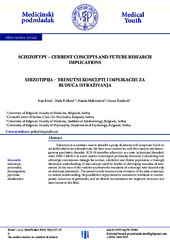Shizotipija - trenutni koncepti i implikacije za buduća istraživanja
Schizotypy: Current concepts and future research implications
| dc.creator | Ristić, Ivan | |
| dc.creator | Marić, Nađa P. | |
| dc.creator | Maksimović, Nataša | |
| dc.creator | Knežević, Goran | |
| dc.date.accessioned | 2021-10-12T12:54:24Z | |
| dc.date.available | 2021-10-12T12:54:24Z | |
| dc.date.issued | 2019 | |
| dc.identifier.issn | 0369-1527 | |
| dc.identifier.uri | http://reff.f.bg.ac.rs/handle/123456789/2725 | |
| dc.description.abstract | Shizotipija je konstrukt koji se koristi kako bi se opisala grupa osoba sa simptomima koji ne ispunjavaju kriterijume za postavljanje dijagnoze shizofrenije, ali imaju sličnosti sa ovim kompleksnim i heterogenim psihiajtrijskim oboljenjem. MKB-10 opisuje shizotipiju kao privremeno stanje (shizotipalni poremećaj), dok je DSM-5 opisuje kao trajniji poremećaj (shizotipalni poremećaj ličnosti). S obzirom da se shizotipija prostire kroz normalnu, supkliničku i kliničku populaciju, temeljno teorijsko razumevanje ovog koncepta može biti od pomoći prilikom razvijanja mera procene shizotipije. Do sada, najveći deo psihometrijske evaluacije shizotipije bazirao se na varijetetima individualnih razlika (poremećaja) ličnosti. Ovaj članak se fokusira na evoluciju termina shizotipije, na razumevanje ovog fenomena, mogućnosti psihometrijske procene u skladu sa trenutnim modelima ličnosti i na klinička razmatranja koja bi dovela do poboljšane detekcije i intervencije u ovoj oblasti. | sr |
| dc.description.abstract | Schizotypy is a construct used to describe a group of persons with symptoms which do not fulfill criteria for schizophrenia, but have some similarities with this complex and heterogeneous psychiatric disorder. ICD-10 describes schizotypy as a state (schizotypal disorder), while DSM-5 labels it as a trait marker (schizotypal personality disorder). Considering how schizotypy encompasses through the normal, subclinical and clinical population, a thorough theoretical understanding of this concept could be helpful in developing measures of assessment. So far, most of the tools for psychometric evaluation of schizotypy have focused only on abnormal personality. The present article focuses on the evolution of the term schizotypy, its current understanding, the possibilities of psychometric assessment in relation to contemporary constructs of personality and on clinical considerations for improved detection and intervention in this field. | en |
| dc.publisher | Univerzitet u Beogradu - Medicinski fakultet, Beograd | |
| dc.rights | openAccess | |
| dc.rights.uri | https://creativecommons.org/licenses/by/4.0/ | |
| dc.source | Medicinski podmladak | |
| dc.subject | shizotipija | sr |
| dc.subject | psihoza | sr |
| dc.subject | ličnost | sr |
| dc.subject | klasifikacija | sr |
| dc.subject | dezintegracija | sr |
| dc.subject | schizotypy | en |
| dc.subject | psychosis | en |
| dc.subject | personality | en |
| dc.subject | disintegration | en |
| dc.subject | classification | en |
| dc.title | Shizotipija - trenutni koncepti i implikacije za buduća istraživanja | sr |
| dc.title | Schizotypy: Current concepts and future research implications | en |
| dc.type | article | |
| dc.rights.license | BY | |
| dc.citation.epage | 33 | |
| dc.citation.issue | 4 | |
| dc.citation.other | 70(4): 27-33 | |
| dc.citation.rank | M53 | |
| dc.citation.spage | 27 | |
| dc.citation.volume | 70 | |
| dc.identifier.doi | 10.5937/mp70-23801 | |
| dc.identifier.fulltext | http://reff.f.bg.ac.rs/bitstream/id/1406/2722.pdf | |
| dc.type.version | publishedVersion |

